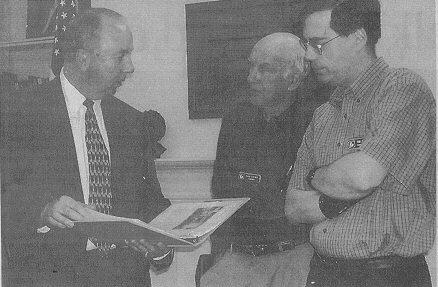By Steve Jusseaume
Hampton Union, Tuesday, April 30, 2002

HAMPTON — In July 1854, following a fire that destroyed the original Leavitt’s Beach Hotel, the Exeter News-Letter reported that an estimated 2,000 people visited the ruins, “but everybody was orderly, with no racing of horses or loud talk.”
Proof, according to the correspondent, that in a country town like Hampton, there was no use to keeping a police force.
“I have often thought that the more police officers we have the more laws we have broken,” the writer speculated.
The above news item is how local historian John Holman began his history of the Hampton Police Department.
Holman presented the history, in a large three-ring notebook, to the department recently at Lane Memorial Library The history is Holman’s latest work. Last year he documented the Fire Department and presented that volume to Chief Hank Lipe in a similar ceremony.
“I enjoy doing this stuff,” said Holman this week, commenting on the work, which he said took him a year or more to write.
According to Holman’s work, crime in Hampton in the 1800s was mostly “petty.” Two dollars was stolen from the post office once in 1889, a time when there were no full-time police officers patrolling the town. But that year two men were appointed to the job, Curtis DeLancey and Charles A. Weare. Two years later, Holman wrote, the first police regulations were issued. No boxes, barrels or other articles were to be placed so as to obstruct a public way; two or more people were not to block any sidewalks; no one could loiter about the doors of any hail, store, office or saloon; no obstructions were permitted on any sidewalk or at the corner of any street.
Most of Holman’s material caine from Peter Randall’s ‘History of Hampton,” he said, besides local newspapers and town reports. “I looked through quite a few town reports compiling the information,” Holman said.
In July 1900, Holman reported, the first beach station was build adjacent to the Manchester Hotel. It was 12 feet by 16 feet and contained three cells and an officers’ room. The following year the town paid $682.97 for police protection, with $400 going to Gerald A. Smith, who apparently was the chief.
In June 1907 an automobile driver was fined $14 for speeding. “On Tuesday no less than 11 large motors were held up and cautioned to proceed within the limits allowed,” the Hampton Union reported on day, according to Holman. Speed limits had first been posted in 1904.
One major police duty in the period surrounding 1915 was to stop the sale of illegal liquor at the beach, Holman wrote.
The history of the department runs right up to the present, as the town attempts to build a new $6.3 million station house at the beach.
Also included in the history are photographs, court logs, police rosters from the mid-2Oth century, a section on the mounted police, and the saga of Hampton “singing cop.
Current Police Chief Bill Wrenn accepted the history on behalf of the department.
“The timing of this couldn’t have been more perfect,” Wrenn said, adding that the department is currently compiling police memorabilia, which will ultimately be placed on display at the new station house.
“Stuff like this just really adds to our collection. It’s great,” Wrenn said.
Holman is not sure what his next project will be, but he noted that he is researching Flag Day and the town’s cemeteries.